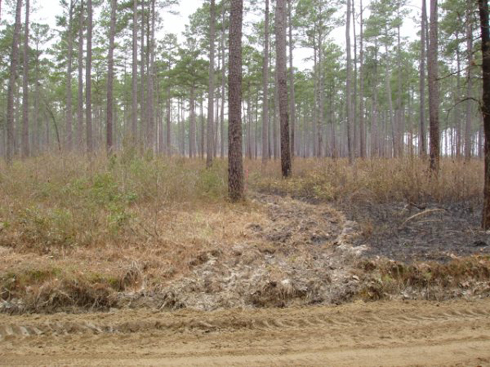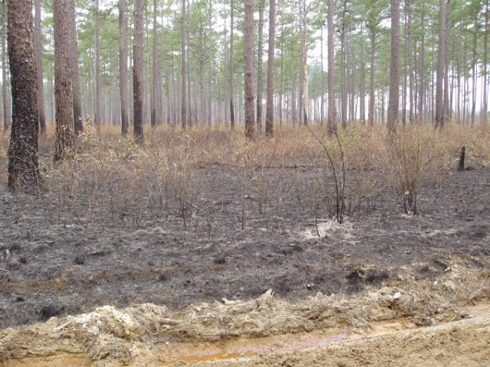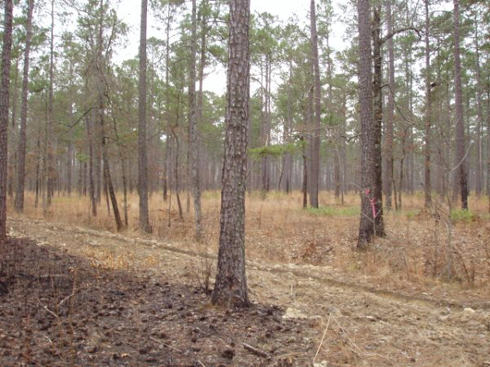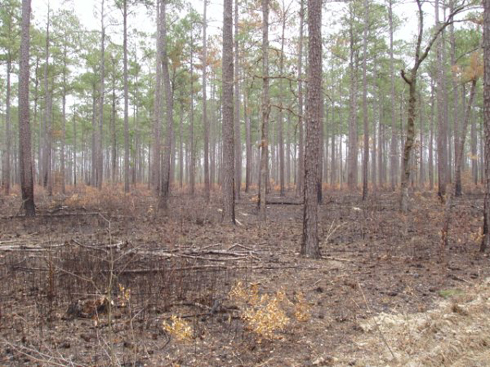Politics and politicians Private land policies Saving Forests The 2010 Fire Season
by admin
Prescribed Burning and Assuming Responsibility
Note: the author is a registered professional consulting forester (#475) in South Carolina and principal of Carolina Forest Stewards, Inc. headquartered in Georgetown, SC.
by Travis C. Cork, III
Last Tuesday I finished burning one of my client’s quail havens. The area is divided into 6 blocks, and weather permitting, I burn 3 blocks (2,4,6) one year and three the next (1,3,5). In last 25 years, I have burned this property 10-12 times. Pictures are attached. In confirmation of findings of research at Santee Experimental Forest in Francis Marion National Forest, you can see the damned sweet gum is still there. Unfortunately, so is Smilax sp. and Rubus.




Before and after prescribed burning in a South Carolina loblolly pine plantation. Photos by Travis C. Cork, III.
It would be hard to find a safer place to burn. Fuel loads are low. The only hazard is smoke, and the property is isolated enough for that concern to be minimal. Besides, I started fire about 11:30 and was finished by 3:00. By dark there was no smoke to puddle if we had a temperature inversion.
Yet, I still get nervous before I set the fire. For those who burn under the umbrella of having the taxpayer cover your liability, imagine setting a fire with the knowledge that if you screw up, that it can cost you everything you own. I have liability insurance, but in today’s litigious society, it may not be enough.
South Carolina legislature is considering a law to protect foresters from liability if they screw up on a fire “unless they were grossly negligent.” I am opposed to this. I think that it is good to be nervous before setting a fire. Part of being good at prescribed burning is understanding that things sometimes change quickly, or understanding that the wind forecast may be flawed.
Not surprisingly, one of experts testifying for this law was from The Nature Conservancy. He was quoted as saying “[O]ur primary tool for managing our lands is prescribed fires. If we don’t burn when we choose, then it’s going to burn when it wants to burn.”
This statement is crap. To start with, no forest burns “when it wants to burn.” Forests are not capable of purposeful action. Excepting the rare lightning strike (here in the Southeast), they burn when someone sets them. For example, the recent catastrophic fire at Myrtle Beach started because someone set it. It spread because government firefighters failed to put it out. Had they done their job thoroughly, the fire would have been nothing but a small trash fire.
Prescribed burning may be a primary tool for TNC as they do not like intensive forestry, but it certainly is not a primary tool for NIPF’s [non-industrial private forestlands]. That TNC wants to be shielded from liability is understandable as it has preserve type properties (Sandy Island and Brookgreen Gardens near Myrtle Beach) that it wants burned. If their fires smoke up the homes on Pawleys Island, so what. The “ecosystem” is more important than the people.
The reality is that prescribed burning is going to have less and less application as a forest management tool, primarily because of smoke issues. Public and quasi-public (TNC) foresters may ignore that, but private sector foresters are not. Responsibility for screw-ups is a good thing. Being able to socialize individual liability creates a moral hazard and makes it more likely there will be a catastrophic screw-up, not less.
Another dumb idea by a forestry profession hopelessly wedded to the State.
